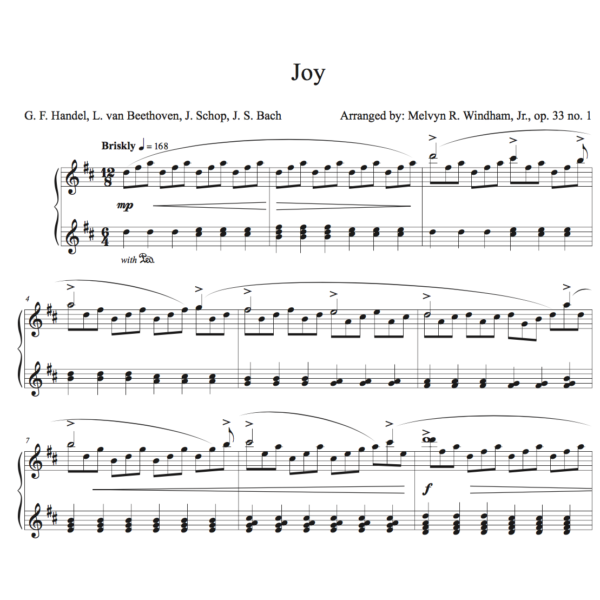Your cart is currently empty!
Showcase: Joy
“Joy” was composed in September 2016, the last of the six preludes I arranged for the collection December. I was looking for an energetic, happy prelude to begin the collection. I played with different ideas: a minimalistic opening, a “Joy to the World” fugue (which almost worked — only a small piece made it into the final product near the end), and merging with other tunes. “Ode to Joy” and “Jesu, Joy of Man’s Desiring” worked pretty well, though I was unable to add in Bach’s triplet patterns in the latter piece — I tried, but the result was unsatisfying — so no triplets.
The prelude is busy, but I’ve found it surprisingly easy to play compared to other pieces in the collection. If you’re looking for a fast, energetic piece that isn’t too difficult to learn, then this might be the prelude you’re looking for.

Practice and Performance Tips:
First section: don’t let the time signatures scare you. They are the same mathematically, but are different because of the rhythms and feel. Just play constant eighth notes, and let the right hand flow. Remember to accent the melody to bring it out.
Second section (starting measure 24): the rhythms come together and are easier. However, the left hand has some tough stretches. Try to bring out “Ode to Joy” in the top notes of each triplet, while at the same time not bringing out the bass Bb notes. You may note that in measure 37, the “Ode to Joy” theme disappears, but it comes back in measure 41. You can milk the Ab’s in that last part.
Third section (starting measure 46): you can take your time on this section. Try to play “Jesu, Man of Joy’s Desiring” softly, while bringing out “Joy to the World.” The middle notes often switch between left and right hand, depending on which hand can reach them. Repetitive practice can help you get them straight. You may need to roll some chords that aren’t marked.
Final section (starting measure 70): play it big, and not too fast. The sixteenth notes are meant to simulate bells ringing, so feel free to hold down the sustain pedal as much as you want. You’ll most likely have to memorize the right hand, as it jumps around frequently. Measure 76 is a temporary return to the original minimalistic arrangement. Play that part noticeably softer. Measure 80 comes back to the big finish. Really play out the last statement of the melody in bass in the last three measures.
In sacrament meeting, you can simply play the final section softer, and it still works.
Sound sample:
by
Tags:

Leave a Reply